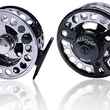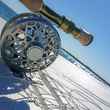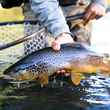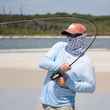See our updated for 2015-2016 list of best fishing sunglasses.
As we’ve noted in previous “best of” features, that term should be taken with a grain of salt. Even though the internet is flush with lists of the best of this or that, the reality is that few -- if any -- of the outlets that publish such lists can claim to have sufficiently tested the field well enough to declare any one item the best.
What you’re reading is more accurately described as our favorite fishing sunglasses of 2013. That said, what follows represents a year of on-the-water testing of dozens of pairs of fishing sunglasses -- including offerings from a diverse array of manufacturers -- in a wide variety of circumstances and environments in which one might find themselves when pursuing their fishy quarry.
It’s also worth noting that we’re changing the format this year a bit. While we’ve previously highlighted specific pairs of sunglasses that we consider standouts amongst the crowd, this year we’re selecting the best lenses across a group of categories. The reality is, virtually every sunglass manufacturer offers a select set of lenses spread across a number of frames and, when it comes down to it, it's the lens that matters. Frames are not without consequence however, far from it, and given such we’ll be listing recommended frame choices for each of our selections.
Finally, if you're still making light of your fishing eyewear, stop. We've heard fishing guides describe high-quality, polarized sunglasses as equally important on-the-water gear as your rod, line and flies. Being able to see the fish you're after is often significantly more than half the battle. Even if it means stealing from your rod or reel budget in order to be able to head to the stream with high-quality sunglasses, doing so should be done without pause.
Enough housekeeping. On with the list.
Best Newcomer - Smith Optics ChromaPOP Polarized Brown
Few manufacturers offer truly new products each year, as significant R&D goes into developing new lens technology and there’s little reason to bring new products to the market each year. New sunglass offerings most often come in the form of new frames/styles, with new lens offerings coming on a multi-year cycle.

Of this year’s truly new offerings, the far and away standout is Smith Optics’ new ChromaPOP lenses.
Smith calls its new ChromaPOP lenses the “most scientifically advanced polarized lens” in the world. The lenses feature an entirely new, proprietary manufacturing process that produces unlaminated polarized lenses. In other words, the polarization is built into the lens material, rather than requiring the addition of a film. The lenses aren’t glass, or traditional polycarbonate, but rather an entirely new plastic-based material.
The ChromaPOP lenses also feature new spectrum-filtering technology designed to increase optical clarity. According to Smith Optics’ Peter Crow, "ChromaPop lenses selectively filter light out in the optically confusing transmission areas of 480nm and 580nm, with the result of brighter more vibrant and popping colors. The lenses are lighter in weight than any other lens material, 4 to 5 times more scratch resistant than Polycarbonate, have the impact resistance of Polycarbonate and the clarity of glass."
And we’re buying all of it. Whatever Smith has cooked up with the ChromaPOP lenses, it undeniably makes the world pop. And the benefits aren’t limited to making an otherwise drab day seem picturesque. The increased visual contrast produced by the lenses serves as a valuable tool when on the water. When fishing on Pennsylvania’s Lehigh River, with its characteristic tannic stain that makes spotting holding trout a chore, the ChromaPOP allowed us to pick out fins and profiles that even Smith’s excellent, glass Polarchromic Copper Brown lens didn’t highlight as readily.
The ChromaPOPs are the first non-glass lens that, despite many polycarbonate and plastic lenses claiming so, actually offers optical clarity that we found to be indistinguishable from glass. Maybe my six year old's eyes would be able to tell the difference, but our adult versions couldn't. The lenses also wear incredibly light, offering up similar comfort as cheapo plastic frames and lenses that are not otherwise worth a damn.
If it were not for the fact that the brown polarized ChromaPOPs are what could be called an “everyday lens”, meaning they’re intended for the average, sunny day that would normally prompt you to don them, and not versatile enough to excel in specialized situations (for instance heavily overcast days or otherwise low light situations), they’d likely be our pick not only for best newcomer but best overall.
Recommended frames: Chief, Dover
BUY THE SMITH OPTICS CHIEF w/ CHROMAPOP POLARIZED BROWN LENS (via Amazon.com)
Best Low Light Lens - Maui Jim HT
Maui Jim’s HT (high tranmission) lens made our last best of list, and it’s back again. The truth is, these lenses see almost as much use as some of the “everyday” lenses described above. This is a result of the fact that, especially for the freshwater fisherman, lighting conditions vary widely. A great deal of fishing is done in the early morning or late evening hours, cloudy days are common (and welcomed), and fishing many streams involves operating under a forest canopy which may often block the bulk of the sun’s rays. Having a lens that can offer up the benefits of polarization and contrast-enhancing light filtering while not eliminating too much light is invaluable.

It’s worth repeating some of our thoughts from last time around, Maui Jim’s “HT lens is designed to offer better visibility in low-light situations such as early morning and evening while boosting depth-of-field and contrast. We unsurprisingly found it to do exactly that but were also surprised at how well-rounded the HT lens turned out to be. Not only did the HT lens allow us to wear polarized lenses when other sunglasses we tested were much too dark (and we're talking very early morning and till near-dark in the evening), but they've become our all-day lenses on overcast days and also carried us through much of the day on all but the sunniest of outings.”
After years of wearing Maui’s HT lens in a variety of frames -- frames which it also bears noting again are, with their seemingly bulletproof spring hinges and sturdy feel, still consistently heads and tails above the competition in terms of quality and construction -- we’re still shocked by the world that the HT lenses “open up” on cloudy, dreary days.
Recommended frames: World Cup, Seawall
BUY THE MAUI JIM WORLD CUP w/ HT LENS (via Amazon.com)
Honorable Mention - Smith Optics Low Light Polarized Ignitor
Another truly all-new offering from Smith Optics, the glass Low Light Polarized Ignitor is the first lens we’ve seen come along that stands to compete with Maui Jim’s HT lens. Smith’s low light lens has a pronounced yellow-amber hue, while the Maui HT has a more neutral cast, and as such presents a different but equally impressive field of vision in low-light situations.

Both offer different visual advantages, but the Maui HT is a more versatile low-light lens. That said, the Low Light Ignitor -- with their 40 percent light transmission -- will take you into even lower light situations than the HT will. And if there’s a better rainy day driving lens, we’ve yet to encounter it.
Recommended frames: Dover, Chief
BUY THE SMITH CHIEF w/ LOW LIGHT IGNITOR LENS (via Amazon.com)
Part Two
Continue on to Part Two of our Best Fishing Sunglasses of 2013 for our picks for Best Saltwater lens and Best Overall.































Comments
Steve K replied on Permalink
Do you know if CromaPop is available for prescription sunglasses?
Chad Shmukler replied on Permalink
It doesn't appear so, Steve. Smith seems to have an entirely different line of lenses for their prescription eyewear.
Steve K replied on Permalink
In that case, can you do a Part III review of the best prescription sunglasses?
Chad Shmukler replied on Permalink
Steve -- whatever the way that prescription glasses get worked into future features (too late to include it in the 2013 feature), the point raised by your questions is a good one: we've not been factoring in the importance of prescription availability. Whether we add it as a factor on which we make our selections, or -- as you suggest -- add a separate category, we definitely should make it part of the equation in the future.
Mike Sepelak replied on Permalink
Don't know how I missed this. I LOVE my Maui HTs for all the reasons you suggest. They're now a "must pack" before every outing, regardless of the conditions to be faced. Great call.
Anonymous replied on Permalink
I do agree with you.
Dave replied on Permalink
Respectfully disagree on the order of the MJ HT and the Smith Low Light Ignitors. The Smith Ignitors are the best low light lens, period. They are tough on sensitive eyes in sunlight, however. The Smith's outperform the MJ HT lens in low light, but the MJ HT crush the Smith's in normal conditions. That's from using the MJ HT for 4 years and Smith's the past year - all exclusively for sight-fishing brown trout. Cheers!
Chad Shmukler replied on Permalink
No big disagreement Dave. As noted, the Ignitors are excellent low light lenses. The Maui HTs got the edge because if their excellent low light performance plus added versatility.
Pages